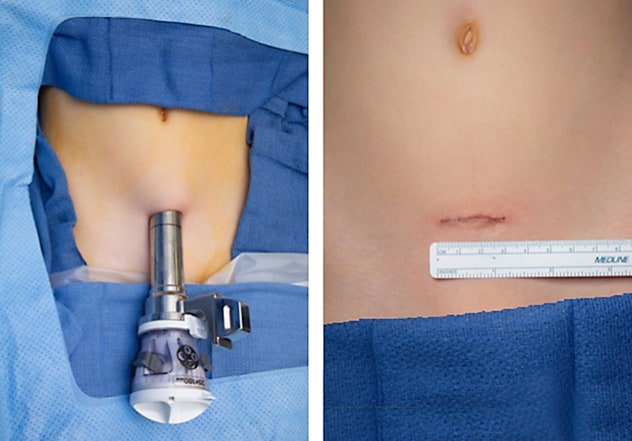June 21, 2019
In the past two decades, technology has advanced to augment an already minimally invasive approach in laparoscopic surgery. Robot-assisted laparoscopic platforms have evolved from a minimum of three working ports to their fourth-generation product: A single-port system first cleared through the Food and Drug Administration for urologic procedures in 2018.
HIdES approach for robotic-assisted dismembered pyeloplasty

HIdES approach for robotic-assisted dismembered pyeloplasty
Using the hidden incision endoscopic surgery (HIdES) approach, a single port is placed below the Pfannenstiel line through a 2.5-cm incision for a robot-assisted dismembered pyeloplasty in a 10-year-old girl.
In the single-port system, a single, 2.5-cm incision allows for placement of a cannula or port that admits a fully wristed camera as well as three fully wristed instruments, all controlled by the surgeon at the console. Single-port procedures were used initially in adult urologic reconstructive and oncologic procedures.
Single-port pediatric procedures
Pediatric urologists Patricio C. Gargollo, M.D., and Candace F. Granberg, M.D., at Mayo Clinic in Rochester, Minnesota, have performed the first single-port pediatric procedures in the world, including pyeloplasty and an appendicovesicostomy.
Their approach differs from most conventional approaches, in which the port is placed through or around the bellybutton; rather, the transverse incision is made in the low pelvis, or below the Pfannenstiel incision. This technique of hidden incision endoscopic surgery (HIdES) was first developed by Dr. Gargollo and published in The Journal of Urology in 2011. Dr. Gargollo's goal was to eliminate visible scars on the abdomen.
Dr. Gargollo used his HIdES approach for the first pediatric single-port robotic procedure. "The HIdES technique is perfectly suited for the single-port platform, particularly for kidney procedures," says Dr. Gargollo. "We have reported previously that patients and parents prefer the HIdES incisions over those from traditional port placement, which are still visible on the belly. Having used the HIdES approach for years, it was natural for me to place the single port below the swimsuit line and advance the camera and instruments to the kidney."
The cases did not differ significantly in operative time when compared with standard three-port robotic approaches. There were no intraoperative complications and procedures were completed purely single-port for the pyleoplasties.
Pain control was also comparable to historic controls performed with a three-port robotic approach, utilizing only alternating acetaminophen and ibuprofen post-operatively, with no opioids required.
Dr. Gargollo says that time will tell if the HIdES approach offers even better pain control than standard robotic approaches. "Many patients, both children and adults, will complain of pain from the umbilical incision after laparoscopic or robotic surgery. But if we use a low incision and inject local anesthetic, these kids are remarkably comfortable and really report almost no pain."
Current limitations
Dr. Granberg says there are limits to use of the single-port system in children. "In order to be able to fan out the wristed instruments and endoscope, you must be at least 10 cm away from where you need to work. Because of this, we need to carefully select in which kids we can use this system; toddlers and those younger are too small with the current technology. We are hopeful that with advances in the system that inevitably come with time, the miniaturization of instrumentation and the platform will allow for a shorter working distance."
In addition to the size limitations of pediatric patients, the single-port system's capabilities are also restricted by the instruments available within the platform. Certain energy sources, clip appliers, staplers and other select working instruments are not yet available on the single-port system. As a result, adult urologic surgeons have employed an additional laparoscopic-assist port when needed.
The single-port robotic system offers an exciting, novel approach for minimally invasive surgery. Patient and procedure selection are key in offering safe, efficacious procedures in children using this new platform. Further study is necessary to document any differences in perioperative outcomes, and patient and parent satisfaction.
For more information
Gargollo PC. Hidden incision endoscopic surgery: description of technique, parental satisfaction and applications. The Journal of Urology. 2011;185:1425.